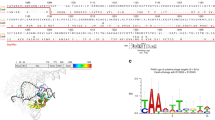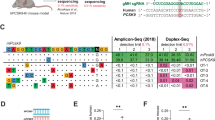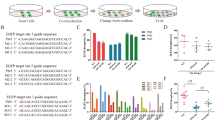Abstract
CRISPR-Cas9 nucleases target specific DNA sequences using a guide RNA but also require recognition of a protospacer adjacent motif (PAM) by the Cas9 protein. Although longer PAMs can potentially improve the specificity of genome editing, they limit the range of sequences that Cas9 orthologs can target. One potential strategy to relieve this restriction is to relax the PAM recognition specificity of Cas9. Here we used molecular evolution to modify the NNGRRT PAM of Staphylococcus aureus Cas9 (SaCas9). One variant we identified, referred to as KKH SaCas9, showed robust genome editing activities at endogenous human target sites with NNNRRT PAMs, thereby increasing SaCas9 targeting range by two- to fourfold. Using GUIDE-seq, we show that wild-type and KKH SaCas9 induce comparable numbers of off-target effects in human cells. Our strategy for evolving PAM specificity does not require structural information and therefore should be applicable to a wide range of Cas9 orthologs.
This is a preview of subscription content, access via your institution
Access options
Subscribe to this journal
Receive 12 print issues and online access
$209.00 per year
only $17.42 per issue
Buy this article
- Purchase on Springer Link
- Instant access to full article PDF
Prices may be subject to local taxes which are calculated during checkout



Similar content being viewed by others
Accession codes
References
Hsu, P.D., Lander, E.S. & Zhang, F. Development and applications of CRISPR-Cas9 for genome engineering. Cell 157, 1262–1278 (2014).
Sander, J.D. & Joung, J.K. CRISPR-Cas systems for editing, regulating and targeting genomes. Nat. Biotechnol. 32, 347–355 (2014).
Doudna, J.A. & Charpentier, E. Genome editing. The new frontier of genome engineering with CRISPR-Cas9. Science 346, 1258096 (2014).
Jinek, M. et al. A programmable dual-RNA-guided DNA endonuclease in adaptive bacterial immunity. Science 337, 816–821 (2012).
Deltcheva, E. et al. CRISPR RNA maturation by trans-encoded small RNA and host factor RNase III. Nature 471, 602–607 (2011).
Jinek, M. et al. RNA-programmed genome editing in human cells. eLife 2, e00471 (2013).
Mali, P. et al. RNA-guided human genome engineering via Cas9. Science 339, 823–826 (2013).
Cong, L. et al. Multiplex genome engineering using CRISPR/Cas systems. Science 339, 819–823 (2013).
Mojica, F.J., Díez-Villaseñor, C., García-Martínez, J. & Almendros, C. Short motif sequences determine the targets of the prokaryotic CRISPR defence system. Microbiology 155, 733–740 (2009).
Shah, S.A., Erdmann, S., Mojica, F.J. & Garrett, R.A. Protospacer recognition motifs: mixed identities and functional diversity. RNA Biol. 10, 891–899 (2013).
Sapranauskas, R. et al. The Streptococcus thermophilus CRISPR/Cas system provides immunity in Escherichia coli. Nucleic Acids Res. 39, 9275–9282 (2011).
Horvath, P. et al. Diversity, activity, and evolution of CRISPR loci in Streptococcus thermophilus. J. Bacteriol. 190, 1401–1412 (2008).
Sternberg, S.H., Redding, S., Jinek, M., Greene, E.C. & Doudna, J.A. DNA interrogation by the CRISPR RNA-guided endonuclease Cas9. Nature 507, 62–67 (2014).
Jiang, W., Bikard, D., Cox, D., Zhang, F. & Marraffini, L.A. RNA-guided editing of bacterial genomes using CRISPR-Cas systems. Nat. Biotechnol. 31, 233–239 (2013).
Fonfara, I. et al. Phylogeny of Cas9 determines functional exchangeability of dual-RNA and Cas9 among orthologous type II CRISPR-Cas systems. Nucleic Acids Res. 42, 2577–2590 (2014).
Esvelt, K.M. et al. Orthogonal Cas9 proteins for RNA-guided gene regulation and editing. Nat. Methods 10, 1116–1121 (2013).
Ran, F.A. et al. In vivo genome editing using Staphylococcus aureus Cas9. Nature 520, 186–191 (2015).
Zhang, Y. et al. Processing-independent CRISPR RNAs limit natural transformation in Neisseria meningitidis. Mol. Cell 50, 488–503 (2013).
Vierstra, J. et al. Functional footprinting of regulatory DNA. Nat. Methods 12, 927–930 (2015).
Canver, M.C. et al. BCL11A enhancer dissection by Cas9-mediated in situ saturating mutagenesis. Nature doi:10.1038/nature15521 (16 September 2015).
Courtney, D.G. et al. CRISPR/Cas9 DNA cleavage at SNP-derived PAM enables both in vitro and in vivo KRT12 mutation-specific targeting. Gene Ther. doi:10.1038/gt.2015.82 (20 August 2015).
Kleinstiver, B.P. et al. Engineered CRISPR-Cas9 nucleases with altered PAM specificities. Nature 523, 481–485 (2015).
Jinek, M. et al. Structures of Cas9 endonucleases reveal RNA-mediated conformational activation. Science 343, 1247997 (2014).
Anders, C., Niewoehner, O., Duerst, A. & Jinek, M. Structural basis of PAM-dependent target DNA recognition by the Cas9 endonuclease. Nature 513, 569–573 (2014).
Nishimasu, H. et al. Crystal structure of Cas9 in complex with guide RNA and target DNA. Cell 156, 935–949 (2014).
Fu, Y. et al. High-frequency off-target mutagenesis induced by CRISPR-Cas nucleases in human cells. Nat. Biotechnol. 31, 822–826 (2013).
Tsai, S.Q. et al. GUIDE-seq enables genome-wide profiling of off-target cleavage by CRISPR-Cas nucleases. Nat. Biotechnol. 33, 187–197 (2015).
Lin, Y. et al. CRISPR/Cas9 systems have off-target activity with insertions or deletions between target DNA and guide RNA sequences. Nucleic Acids Res. 42, 7473–7485 (2014).
Fu, Y., Sander, J.D., Reyon, D., Cascio, V.M. & Joung, J.K. Improving CRISPR-Cas nuclease specificity using truncated guide RNAs. Nat. Biotechnol. 32, 279–284 (2014).
Nishimasu, H. et al. Crystal structure of Staphylococcus aureus Cas9. Cell 162, 1113–1126 (2015).
Chen, Z. & Zhao, H. A highly sensitive selection method for directed evolution of homing endonucleases. Nucleic Acids Res. 33, e154 (2005).
Kleinstiver, B.P., Fernandes, A.D., Gloor, G.B. & Edgell, D.R. A unified genetic, computational and experimental framework identifies functionally relevant residues of the homing endonuclease I-BmoI. Nucleic Acids Res. 38, 2411–2427 (2010).
Reyon, D. et al. FLASH assembly of TALENs for high-throughput genome editing. Nat. Biotechnol. 30, 460–465 (2012).
Acknowledgements
We thank D. Edgell (University of Western Ontario) for providing the bacterial strain and precursor plasmids related to the bacterial selections, T. Cathomen (Freiburg) for providing the U2OS cells, and J. Angstman for comments on the manuscript. This work was supported by a US National Institutes of Health (NIH) Director's Pioneer Award (DP1 GM105378) and NIH R01 GM107427 to J.K.J., the Jim and Ann Orr Research Scholar Award (to J.K.J.), and a Natural Sciences and Engineering Research Council of Canada Postdoctoral Fellowship (to B.P.K.). New reagents described in this work will be deposited with the nonprofit plasmid distribution service Addgene (http://www.addgene.org/crispr-cas).
Author information
Authors and Affiliations
Contributions
B.P.K. and M.S.P. performed all bacterial and human cell experiments, and N.T.N. assisted with GUIDE-seq experiments. S.Q.T., V.V.T. and Z.Z. analyzed the site-depletion and GUIDE-seq data. B.P.K. and J.K.J. directed the research, interpreted experiments, and wrote the manuscript with input from all authors.
Corresponding authors
Ethics declarations
Competing interests
J.K.J. is a consultant for Horizon Discovery. J.K.J. has financial interests in Editas Medicine, Hera Testing Laboratories, Poseida Therapeutics and Transposagen Biopharmaceuticals. J.K.J.’s interests were reviewed and are managed by Massachusetts General Hospital and Partners HealthCare in accordance with their conflict of interest policies. A patent application has been filed describing the KKH SaCas9 variant.
Integrated supplementary information
Supplementary Figure 1 Protein domain alignment of Cas9 orthologues
Cas9 orthologues from Fig. 1a were aligned using ClustalW2. The domain structure of SpCas9 is shown at the top (based on PDB:4UN3; Anders et al., 2014); the PAM contacting residues of SpCas9 are highlighted; the region of SaCas9 mutagenized to select for altered PAM specificity variants is shown.
Supplementary Figure 2 Primary sequence alignment of Cas9 orthologues for identification of PAM-interacting residues
SpCas9 residues previously identified (Anders et al., 2014; Kleinstiver et al., 2015) to be important for contacting the PAM are highlighted in blue, residues capable of modulating SaCas9 PAM specificity (identified in this study) are highlighted in orange, and positively charged residues adjacent to R1015 are highlighted in yellow. The structurally predicted PAM-interacting domain of SpCas9 is highlighted with a blue dashed line (based on PDB:4UN3; Anders et al., 2014), and the conservative estimate of the SaCas9 PAM-interacting domain used as a boundary for PCR mutagenesis is indicated with an orange dashed line.
Supplementary Figure 3 Schematic of the bacterial positive selection assay
(a) The selection plasmids can be modified to screen for Cas9 variants that are able to recognize alternative PAM sequences. (b) Schematic of the positive selection plasmids (left panel) and expected outcomes (right panel) when screening functional or non-functional Cas9/sgRNA pairs in the positive selection.
Supplementary Figure 4 Amino acid sequences of SaCas9 variants that conveyed activity against non-canonical PAMs
Selections were performed using a library derived from wild-type SaCas9 as a starting template for PCR mutagenesis. Mismatches to wild-type SaCas9 are highlighted; mutagenesis was conducted based on a conservative estimate of the PI domain (see also Supplementary Figs. 1 and 2).
Supplementary Figure 5 Amino acid sequences of R1015Q SaCas9 variants that conveyed activity against non-canonical PAMs
Selections were performed using a library derived from R1015Q SaCas9 as a starting template for PCR mutagenesis. Mismatches to wild-type SaCas9 are highlighted; mutagenesis was conducted based on a conservative estimate of the PI domain (see also Supplementary Figs. 1 and 2).
Supplementary Figure 6 Activity of additional SaCas9 variants
EGFP disruption activity quantified by flow cytometry; error bars represent s.e.m, n = 3, mean level of background EGFP loss represented by the dashed red line.
Supplementary Figure 7 Schematic of the bacterial site-depletion assay
Site-depletion plasmids with 8 randomized nucleotides in place of the PAM that are refractory to cleavage by wild-type or KKH SaCas9 are sequenced. Targetable PAMs are inferred by their depletion relative to the input library, calculated as the post-selection PAM depletion value (PPDV).
Supplementary Figure 8 Site-depletion assay results for wild-type and KKH SaCas9
(a) PPDV values for dCas9 control experiments on both libraries. The red dashed line indicates statistical significance (PPDV = 0.794, see panel b); grey dashed line indicates 5-fold depletion; PPDVs for a window comprising the 3rd/4th/5th/6th positions of the PAM are plotted (for this and panel c). (b) Statistically significant post-selection PAM depletion values (PPDVs) were determined from the dCas9 control experiments in panel a. Statistical significance was determined by setting the threshold at 3.36 times the standard deviation. (c) Comparison of the PPDVs for wild-type and KKH SaCas9 for each of the two libraries containing 8 randomized nucleotides in place of the PAM. (d) and (e) PAMs and corresponding PPDV values for all PAMs depleted greater than 5-fold for wild-type and KKH SaCas9, respectively. Sequence motifs are shown for PAMs in two categories: 1) greater than 10 fold or 2) 5- to 10-fold depleted.
Supplementary Figure 9 Additional characteristics of endogenous sites targeted by KKH SaCas9
(a) Activity for each of the 55 endogenous site sgRNAs, binned based on the 16 possible NRR motifs of an NNNRRT PAM. Mean activities from Fig. 2a are shown for this and panels b and c. (b) and (c) Relationship between endogenous gene disruption activity and GC content of t he spacer and PAM, respectively. (d) Sequence logos for the spacer and PAM of target sites binned based on activity. Sites were grouped based on mean mutation frequency (from Fig. 2a) into low (0-10%, 17 sites), medium (10-30%, 17 sites), or high (>30%, 21 sites) activity.
Supplementary Figure 10 On-target tag integration and mutagenesis frequencies for GUIDE-seq experiments
(a) Restriction fragment length polymorphism (RFLP) analysis to determine the mean GUIDE-seq tag integration frequencies. Error bars represent s.e.m., n = 3 (for this and panel b). (b) Mean mutagenesis detected by T7E1 assay.
Supplementary Figure 11 A truncated repeat:anti-repeat SaCas9 sgRNA outperforms the full length sgRNA
Similar to previous results (Ran et al., 2015) (a) Human cell EGFP disruption activity for wild-type SaCas9 against 4 sites that contain NNGRRT PAMs. EGFP disruption activity quantified by flow cytometry; error bars represent s.e.m, n = 3, mean level of background EGFP loss represented by dashed red line (for this and panel b). (b) Human cell EGFP disruption activity for KKH SaCas9 against 8 sites that contain NNNRRT PAMs.
Supplementary information
Supplementary Text and Figures
Supplementary Figures 1–11 and Supplementary Notes 1–2 (PDF 2468 kb)
Supplementary Note 1
Supplementary Note (PDF 287 kb)
Supplementary Note 2
Supplementary Sequences – Plasmids used in this study (PDF 229 kb)
Rights and permissions
About this article
Cite this article
Kleinstiver, B., Prew, M., Tsai, S. et al. Broadening the targeting range of Staphylococcus aureus CRISPR-Cas9 by modifying PAM recognition. Nat Biotechnol 33, 1293–1298 (2015). https://doi.org/10.1038/nbt.3404
Received:
Accepted:
Published:
Issue Date:
DOI: https://doi.org/10.1038/nbt.3404
This article is cited by
-
Domain-inlaid Nme2Cas9 adenine base editors with improved activity and targeting scope
Nature Communications (2024)
-
Efficient and safe therapeutic use of paired Cas9-nickases for primary hyperoxaluria type 1
EMBO Molecular Medicine (2024)
-
Improve meat production and virus resistance by simultaneously editing multiple genes in livestock using Cas12iMax
Science China Life Sciences (2024)
-
Revolutionizing Agriculture: Harnessing CRISPR/Cas9 for Crop Enhancement
Indian Journal of Microbiology (2024)
-
The applications of CRISPR/Cas-mediated genome editing in genetic hearing loss
Cell & Bioscience (2023)



